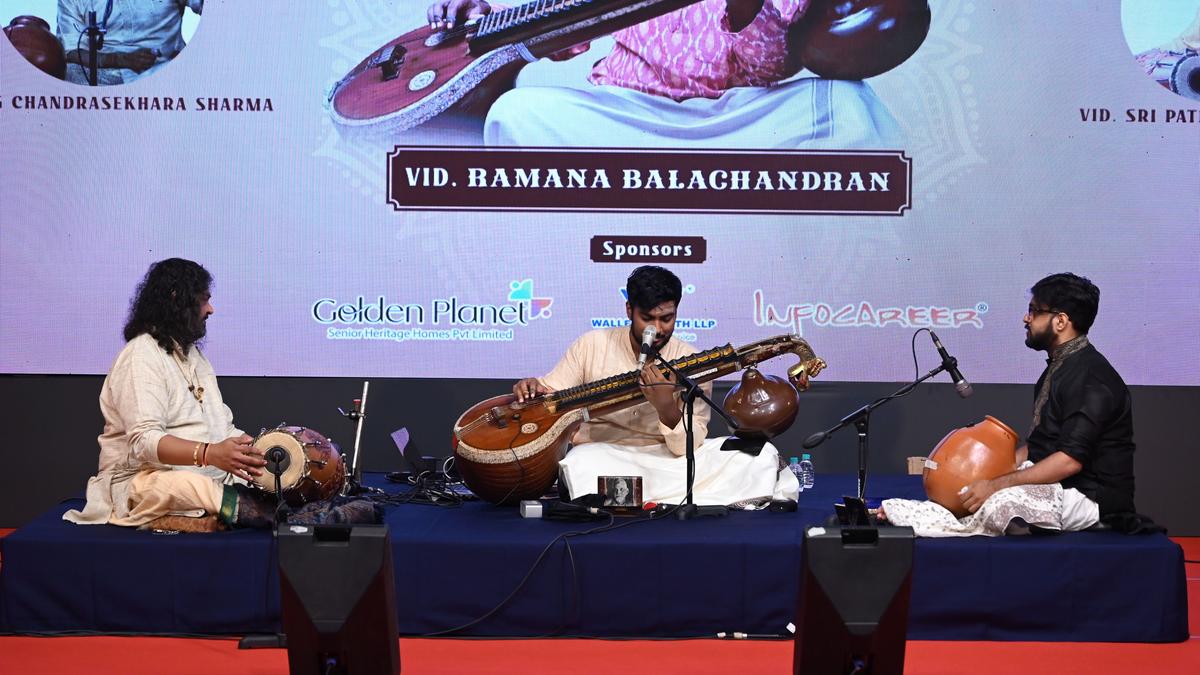
Ramana Balachandran with Patri Satish Kumar on the mridangam and Chandrasekara Sharma on the ghatam.
| Photo Credit: Special Arrangement
It was a little after four when the faint hum of the tambura began to fill the auditorium at Sri Krishna Gana Sabha. A few early listeners had already taken their seats, scattered across the space, while others trickled in, exchanging quiet greetings. Within the next half-hour, the crowd began to thicken, murmurs faded and the air turned expectant.
The occasion was Kala Darbaar, presented by Kalpakalakshmi Charitable Trust, and the evening featured a concert by the young vainika Ramana Balachandhran.
Ramana, with Patri Satish Kumar on the mridangam and Chandrasekara Sharma on the ghatam, began the concert with ‘Velava ennai aalava’, a varnam in Nattakurinji. From the very first phrase, it was evident that this would be more than just a veena recital. Ramana sang along , allowing the sahithyam to weave into the tonal richness of the veena.
Then came Sumukham, a four-note Carnatic raga with swaras ‘Sa Ri Ma Ni’, created by the legendary Balamuralikrishna, that exists without the swara ‘pa’, and the composition ‘Mahaneeya namassulive’, served as an offering to Ganesha. The structure itself was a challenge, yet Ramana’s interpretation was natural and flowing. The kalpanaswaras that followed brought out captured the richness of the raga.
A musical dialogue
The manodharma in Sankarabharanam began with a steady stillness — slow phrases that seemed to breathe. As it grew, so did its emotional gravity, until the audience felt wrapped in its expanse. The poignant composition, Tyagarajar’s ‘Emi neramu nannu brova’ in rettakalai Adi tala, was the sub-main piece of the evening, where the composer’s plea to Rama was carried by Ramana through the strings of the veena with prowess. The kalpanaswaras became a dialogue between the three artistes.
In ragam-tanam-pallavi, set in Purvikalyani, Ramana began with an extensive usage of the bass strings of the veena. The opening phrases established a calm, meditative mood that led to the pallavi, ‘Sada sivane enakku un padhame thunai, ullam kulirndarul puri’ was set in Adi talam, with the eduppu — positioned two syllables before samam.
Being a percussionist himself, Ramana explored the same pallavi in tisra, chatusra and khanda nadais in trikalam. His mastery of raga transitions was evident as he moved effortlessly from Purvikalyani to Kaanada and then to Yamuna Kalyani, maintaining the melodic integrity and rhythmic interest. This section emerged as the high point of the evening, earning a thunderous applause from the audience.
This was followed by the tani avartanam, which began with a simple ‘Na Dhin Dhin Na’ phrase and no sooner evolved into complex rhythmic patterns. Patri Satish Kumar (mridangam) and Chandrasekara Sharma (ghatam) maintained the drive and energy as accompanists, keeping the audience engaged throughout the performance.
Song and string
Next was ‘Sabalyame nin darisanam aiyya’, a composition by Sadhu Om on Ramana Maharishi, set to tune in Suddha Sarang. The veena brought out the devotional depth of the composition with clarity and Ramana’s soft vocal phrases added warmth to the mood. However, the fast-paced percussion accompaniment contrasted this otherwise soulful and emotional composition.
The hall, which was almost houseful, reverberated with divinity, as Ramana ended the concert with Jayadevar’s Ashtapadi, ‘Nijagadasa yadunandana’ followed by the famous namavali ‘Arunachala shiva’, teleporting the audience to the holy hills of Arunachala.
Published – October 25, 2025 11:34 am IST



